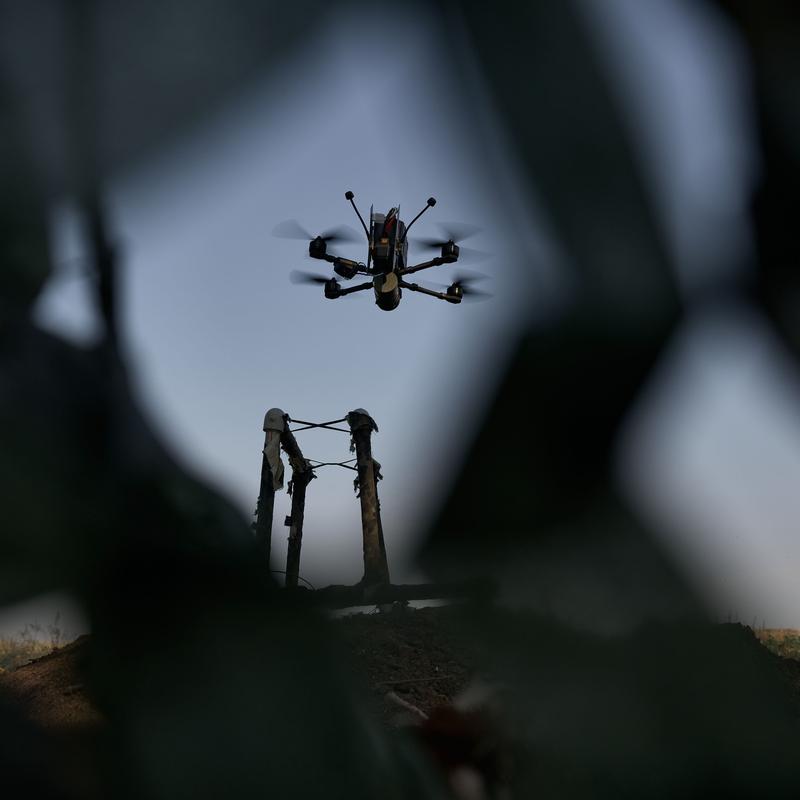Dexter Filkins on Drones and the Future of Warfare

David Remnick: Donald Trump has done a 180 on Ukraine, it seems, after insisting he would end the war very, very quickly with some kind of peace deal, the reality of Russia's war seems to have sunk in.
[clip plays]
Trump: I'm not happy with what Putin is doing. He's killing a lot of people, and I don't know what the hell happened to Putin. I've known him a long time, always gotten along with him, but he's sending rockets into cities and killing people, and I don't like it at all.
[clip ends]
David Remnick: Trump recently announced shipments of Patriot missiles and other weapons to Ukraine. Now, throughout this conflict, we've often talked as though the fate of Ukraine depends entirely on what the US is willing to send them, but there's another story here. Ukraine has been inflicting huge losses on the Russian army, the gigantic Russian army, largely with drones, drones that are dirt cheap and disposable and can be made by the Ukrainians themselves. Some are as small as a couple of pounds.
Staff writer Dexter Filkins has been reporting on this for The New Yorker, and it's a story with huge implications. We may not have taken it on board quite yet, but we have entered a new era where we certainly cannot take US military supremacy for granted. Dexter, you've published a remarkable piece on the future of warfare, and I want to really get into it with you. We tend to think of war as soldiers on the ground and tanks and brigades and divisions, and the warfare that we're seeing, and not only in Ukraine but all around the world, has changed and changed utterly. What does war look like today?
Dexter Filkins: Very, very different, as you said. Yes, fewer soldiers and fewer big tanks and big ships, and more drones and more robots and more things like computer programs like artificial intelligence, that kind of drive targeting and what you should be shooting at. It's becoming highly, highly automated, which in some ways is good, because it kind of pulls the people away from the battlefield, but of course, then it's much more remote in some ways, and so that has its own implications.
David Remnick: When you say it's more remote, what does that mean and what implications are there?
Dexter Filkins: Well, for instance, if the Russians in Ukraine send a division full of soldiers and tanks across the border, they're going to be met not with an equal number of soldiers on the other side but a giant wall of flying bombs, that are drones, which are just going to be crashing into them and trying to stop them. Those drones are being directed by guys miles back, looking through video cameras. In that way, it's very futuristic in that way. That's still an extraordinarily bloody conflict, as we know, but say 80% of the Russian casualties since the beginning of 2024 have been inflicted by drones.
David Remnick: That's an incredible statistic, Dexter. You cite an estimate that drones are responsible for about 80% of Russian casualties and equipment losses. 80%.
Dexter Filkins: Now they are. Now they are, yes. I think it took a while for the Ukrainian drone industry to take off, and now it's really taken off. Last year, the Ukrainians-- None of this existed a few years ago. They built two million drones last year, and they're projected to go much higher this year. They're just cranking them out.
David Remnick: What was the breakthrough technologically that made drone warfare feasible? Because it really does have implications now and going forward.
Dexter Filkins: Well, it's precision guided. Very, very precise guided weapons. Very, very small, but I think above all, very, very cheap. They just don't cost anything to make, and anybody can do it. I visited a drone factory in western Ukraine, and the location of which I did not know, and so I drove and met some Ukrainians in a parking lot and then we moved to their car. They put a blindfold on me, and then we drove. We drove for some distance.
Then sometime later, the blindfold was taken off of me, and I was inside the drone factory, because if the Russians knew where that factory was, they would attack it immediately. In fact, one of them had already been attacked. It was highly secretive, but I was inside. They took the blindfold off, and it was really remarkable. It felt more like an office building. There were cubicles and video cameras and flight simulators. It was super high tech. That's the remarkable thing about what the Ukrainians have done.
They're turning out thousands and thousands, hundreds of thousands, millions of drones of low-cost, precision-guided drones that are remarkable, remarkable not just for how effective they are but how cheap they are. That's what really strikes you. Like I can send this drone down the road to attack anything I want, anything I point it at, it'll hit it right in the forehead, and it costs $500. They were happy to show me videos of their $500 drones crashing into and destroying $5 million Russian weapon systems. That's the great formula that the Ukrainians hit on for 500 bucks.
David Remnick: Presumably Russians have the same technology, right?
Dexter Filkins: Yes, absolutely. They're blanketing Ukraine with drones, and they're sending them in waves into the cities and into Kyiv. Of course, all the Ukrainians have to do is stop the Russians. They're not trying to conquer territory. Their job is just, "We're going to kill Russians," and that's what they're doing. The big Ukrainian tactic that they were talking about when I was there was they would crash one of these into a tank.
They were so accurate that they could steer them right into the gas tank of the tank, which is exposed in a way, it's not heavily armored. The tank explodes. Then everybody gets out and runs, all the Russian soldiers, and then they chase them down with drones. For 500 bucks a piece, they're killing a lot of soldiers and they're destroying a lot of tanks.
David Remnick: Presumably anyone can make them. It doesn't require a nation-state like Ukraine or the United States or Russia?
Dexter Filkins: Anybody can make them.
David Remnick: Well, that's great. That's just great news, Dexter. I mean--
Dexter Filkins: [laughs] People are kind of waking up to the United States. They're thinking, "Oh my God, like, you know what?" You can imagine the potential for a small country to take on a bigger country, but also just really bad people flying these things anywhere they want to go. Particularly for the United States, we've got these multimillion-dollar systems, and so suddenly we have to confront this big question, which is, "Oh my God, are we going to end up like Russia?"
David Remnick: Well, does this make military technology up until very recently completely obsolete?
Dexter Filkins: They say it doesn't. They say, "Well, we still need aircraft carriers, and we're still going to need B-2 bombers." I guess we saw the B-2 bombers in use just a couple of weeks ago.
David Remnick: In Iran.
Dexter Filkins: In Iran, yes, but increasingly it does, because what's happening, and if you just set aside drones, but the idea of really, really cheap and really accurate weapons. The Chinese military, for instance, in the Pacific, their great ambition is to drive the United States out of the western Pacific and out of or away from Taiwan.
The nightmare scenario that the Pentagon, I think, is now finally coming to grips with is, "Well, we've got an 18-billion-dollar aircraft carrier steaming its way towards the western Pacific, and they're going to fire drones at these things, and they're highly, highly accurate, and they move at incredible speeds, but above all, they're cheap, and they're a lot cheaper than the things that we've been building; that we, the United States, have been building, whether it's airplanes or ships or tanks." I think this is the troubling part, the Pentagon is just very slow. It's a big mastodon. The big mastodon is kind of looking at all this and going, "Holy cow, do we need to turn around and do something different?"
David Remnick: Luckily, there's a strategic thinker, Pete Hegseth, in charge of the Pentagon.
Dexter Filkins: [laughs] Yes. The truth is, to give Hegseth credit, and the people around him, the ones that haven't left, have kind of seized onto this, or they say they have, and they say that, "Okay, we get it. We're going to change the Pentagon procurement process. We're going to spend more money on things like drones--" [crosstalk]
David Remnick: Less on what?
Dexter Filkins: Less on things like F-35 fighter jets that cost $100 million each and aircraft carriers that cost $10 billion and a decade to make. We're going to move away from those. Whether they can is a totally different question because again, the Pentagon is so slow, and people have been talking about these things for years, and they've been talking about reforming, getting control of the Pentagon spending process, and nobody has been able to do it. These are conversations that have been taking place for years, but now it's becoming acute, these questions, because of China, because of the rise of China and the rise of the Chinese military.
David Remnick: Speaking of China, earlier this year, the Center for Strategic and International Studies, one of the big centers in DC, gathered experts to conduct a simulated war between the United States and China, a conflict that potentially could come about if China made a move, a strong move against Taiwan. What is a simulated war, and how did it go?
Dexter Filkins: That's really interesting. Each side. There were two teams. It was Team America with Taiwan and Japan, and then Team China over on the other side of the room. They each had at their disposal rough approximations of the weapons that the countries are known to possess. Then they gave the teams a scenario, and they said, "Okay, there's a crisis underway, and the Chinese have begun to blockade Taiwan. They haven't invaded Taiwan, but they're blockading it. Things are getting very tense. The Chinese have just shot down two American patrol planes. Go."
The remarkable thing was how fast it went from two American planes got shot down to World War III. I mean, really, really fast. It was one round and then another and then another and then another. Each one, kind of really terrifying escalation of violence at each step. The Chinese sunk, at one point, three American aircraft carriers. A crew of an American aircraft carrier is 5,000 sailors. There was 15,000 right there. They took out a quarter of the American Air Force.
The United States was launching massive strikes against the Chinese mainland. You could imagine, it's just so sobering, because the weapons on each side are just so powerful and there are so many of them. You just hope that Chinese are doing this too, and that everybody has some idea of how lethal all this would be, because it was really-- The whole thing only took a couple of hours, and it was a gigantic war that was kind of out of control when we stopped.
David Remnick: Dexter, where does artificial intelligence fit into this picture?
Dexter Filkins: Well, AI increasingly is being integrated into everything that the Pentagon is doing, but the real laboratory for that right now, I think, it's fair to say is Gaza and Israel and Lebanon and Hezbollah, and to a certain extent, Iran. What the Israelis built and what was in place when the Gaza war started in 2023, and every war previous, in times of peace, the Israeli military would build up what they call a target list. They had several thousand targets when the massacre happened in Israel in 2023. They shot through that target list very, very fast. The target list is--
David Remnick: It's a human target list, presumably the leadership of Hamas?
Dexter Filkins: Yes. Also, this house has a missile battery underneath the roof. They shot through that list, the IDF, very, very quickly. What happened then, this is when they brought artificial intelligence into the picture. The AI programs were going through oceans of information, hundreds and hundreds of hours of drone feeds. The IDF was using so much computer space that they actually had to rent cloud space from people like Microsoft and Google because they were using so much. These computers could produce, and they did produce hundreds and thousands of targets for the IDF to go after.
What the IDF was very clear about was, to me, this was not killer robots. It wasn't. The robots weren't doing the targeting. There was always a human being making the final decision. The computer would make a recommendation, "You should attack this person" based on the following data that has been assembled. Then it was up to the targeter, the Israeli targeter, I talked to him, the Israeli targeter, to make the final call.
David Remnick: Talk to me about the ethical considerations of this, which I have to think are far-reaching.
Dexter Filkins: Yes.
David Remnick: Some AI experts like Geoffrey Hinton and others are really concerned about the larger use of AI in war in general.
Dexter Filkins: The ethical considerations, they're vast, as you say. I had a long conversation with one of the Israeli targeters, and he said, "Look, we tried to be very deliberate about this. In any given day, the computer would recommend 100 targets, and all of us would go through everything and look at everything, and maybe we would recommend five to our superiors, and maybe then they would take two," but there were others I spoke to who said they felt like they were under pressure to move quickly. They didn't have time to verify everything that the computer was recommending, and so in many cases, they signed off not knowing exactly what they were doing.
David Remnick: It all sounds so cold and precise, and yet-- I was in Israel a couple of weeks ago, and in the space of my time there, Haaretz, the newspaper, published a big piece about the IDF firing on people, and their greatest sin was lining up for a sack of flowers or water. By the way, it continues daily. There have been dozens and dozens of deaths daily of people at aid stations. There was an accurate report of a 500-pound bomb being dropped on a seaside café, and on and on. We talk about this subject rather bloodlessly.
Dexter Filkins: Right.
David Remnick: The military side talks about it with a sense of-- as if this is so great and advanced. The bloodshed is astonishing.
Dexter Filkins: It is, it is.
David Remnick: Dexter, to be frank, the United States in its own adventures in the Middle East was not exactly meticulous or delicate-
Dexter Filkins: That's right.
David Remnick: -in conflicts with Al-Qaeda or ISIS and the rest.
Dexter Filkins: Yes, absolutely. I think each side-- When you talk to the Israeli military, they say, "We're not trying to kill civilians. We're trying not to kill them. We're trying to spare them, and AI can help us be precise," but when the rules are that loose-- I remember when I went in with the Marines to Fallujah, and the rules for that particular military operation had been dialed way far back. It was things like, if you see a guy pick up a cell phone, kill him. If there's an ambulance coming your way, give him one warning shot. If it keeps going, fire. Those were the loosest rules I'd ever seen.
They were in a very particular situation because everyone in the city-- the city was basically empty except for Al-Qaeda, and so it's not quite as shocking as it sounds, but I'd never seen the rules of engagement as loose as the ones that I saw in Israel.
David Remnick: Dexter, the impact of AI and remote targeting, this makes me think about an article you wrote for us recently about the recruiting crisis in the US military. You reported that nearly all the branches of the Military missed their recruiting goals year after year lately. Some of it is because of the economy. Some of it is the physical fitness of young people, and there are other factors. Is this really a big problem anymore? In other words, how many soldiers do we actually need? Because in what you are describing, the notion of masses of human soldiers on a battlefield seems practically to be a thing of the past, or close to it.
Dexter Filkins: Look, I think the US military is actually historically small. I think it's 1.3 million people. It's been steadily declining in numbers for decades. Relatively speaking, we don't have that many troops. That number in the US Military is driven less by strategy than it is by the fact that they can't get any recruits. In that way, it's been determined kind of in a strange way, much of American military strategy is being determined by the fact that the US Military has had such a difficult time getting new recruits.
I think everybody would agree on this, there's no way that you can plan thoroughly for a war in the future. Nobody knows what it's going to look like, and it never looks like what you think it was going to look like. I think the short answer is we can talk about what the war is going to look like and think tanks in Washington can have war games about what they think the future is going to look like. There's a cliché in the military, which is no plan survives contact with the enemy. I think that's the thing to remember.
David Remnick: You can read "The Future of Warfare Comes to America" by staff writer Dexter Filkins at Newyorker.com, and you can subscribe to the magazine there as well at Newyorker.com.
[music]
Copyright © 2025 New York Public Radio. All rights reserved. Visit our website terms of use at www.wnyc.org for further information.
New York Public Radio transcripts are created on a rush deadline, often by contractors. This text may not be in its final form and may be updated or revised in the future. Accuracy and availability may vary. The authoritative record of New York Public Radio’s programming is the audio record.





